
The St. Riquier Gospels are an illuminated manuscript made during the Carolingian renaissance around the year 800 but no later than 814. [1] The Gospel Book is a part of the Ada Group of manuscripts.

The St. Riquier Gospels are an illuminated manuscript made during the Carolingian renaissance around the year 800 but no later than 814. [1] The Gospel Book is a part of the Ada Group of manuscripts.
The manuscript is 198 folios long. It is written on Purple parchment in golden letters. The Gospels and Altar card sections are written in Uncial script (fol. 1–188). The Eusebian Canons are written in Carolingian minuscule (fol. 189–198). The book is illuminated in the Carolingian Style with large decorated initials throughout the text. The design is similar to the Vienna Coronation Gospels. [2] The Portraits of the Evangelists are before Their respective gospel. [3] Matthew (fol. 17v), Mark (fol. 66v), Luke (fol. 101v) and John (fol. 153v).
The manuscript was intended as a gift for Angilbert the lay Abbot of Saint-Riquier Abbey and lover of Charlemagne's daughter Bertha. Angilbert donated the Gospel Book together with numerous other manuscripts to the library of his monastery, where it is listed in an inventory catalogue in 831. [4] Today, the manuscript is kept in nearby Abbeville (Bibliothèque Municipale, Ms. 4). [5]





Lothair I was a 9th-century Carolingian emperor and king of Italy (818–855) and Middle Francia (843–855).
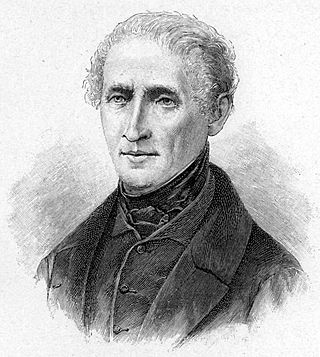
Joseph Freiherr von Eichendorff was a German poet, novelist, playwright, literary critic, translator, and anthologist. Eichendorff was one of the major writers and critics of Romanticism. Ever since their publication and up to the present day, some of his works have been very popular in German-speaking Europe.
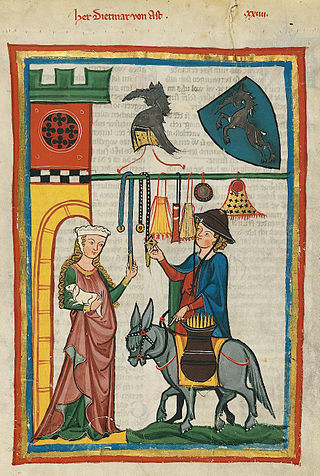
Dietmar von Aist was a Minnesinger from a baronial family in the Duchy of Austria, whose work is representative of the lyric poetry in the Danube region.

The Ludwigslied is an Old High German (OHG) poem of 59 rhyming couplets, celebrating the victory of the Frankish army, led by Louis III of France, over Danish (Viking) raiders at the Battle of Saucourt-en-Vimeu on 3 August 881.

Chelles Abbey was a Frankish monastery founded around 657/660 during the early medieval period. It was intended initially as a monastery for women; then its reputation for great learning grew, and when men wanted to follow the monastic life, a parallel male community was established, creating a double monastery.

Sibylla Schwarz, also known as Sibylle Schwartz was a German poet of the Baroque era.
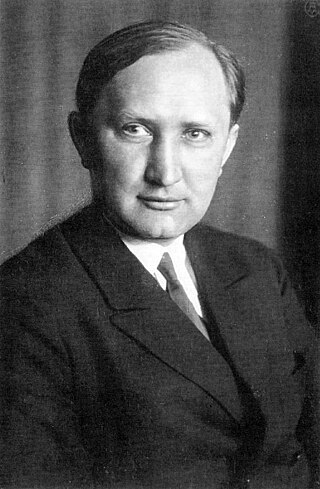
Emil Bock was a German anthroposophist, author, theologian and one of the founders of The Christian Community.

A hoop crown, arched crown, or closed crown, is a crown consisting of a "band around the temples and one or two bands over the head". First used by the Carolingian dynasty, hoop crowns became increasingly popular among royal dynasties in the Late Middle Ages, and the dominant type of crown in the Modern Era.
Der Rütli was a German literary group, named after the famous Swiss meadow. It was founded on 9 December 1852 by members of the Tunnel über der Spree as "a kind of subsidiary tunnel" with a more intimate atmosphere, in contrast to the ceremonial and public nature of the larger group's activities. They met weekly at one another's homes. One major difference between meetings of the Tunnel and meetings of the Rütli was that members' wives were admitted, albeit only after the "work" of the gathering was completed.
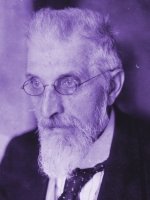
Karl Holl was a professor of theology and church history at Tübingen and Berlin and is considered one of the most influential church historians of his era.
Rudolph Bernhard, originally rabbi Jacob Levi of Prague, was a Christian writer. He was baptised at Bern in 1694. In 1705 he published the proselytizing letter Sendschreiben: Geschrieben an die so genannten Juden. When he died he left a manuscript translation in Hebrew of Matthew, Mark, and Luke up to chapter 16:31.
Bernhard Bischoff was a German historian, paleographer, and philologist; he was born in Altendorf, and he died in Munich.
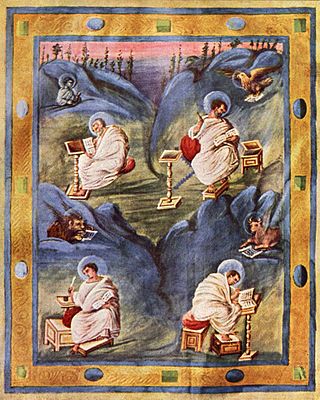
The Aachen Gospels are a Carolingian illuminated manuscript which was created at the beginning of the ninth century by a member of the Ada School. The Evangeliary belongs to a manuscript group which is referred to as the Ada Group or Group of the Vienna Coronation Gospels. It is part of the church treasury of Charlemagne's Palatine Chapel, now Aachen Cathedral, and is today kept in the Aachen Cathedral Treasury. The Treasury Gospels and the more recent Ottonian Liuthar Gospels are the two most significant medieval manuscripts on display there.

The Bernward Doors are the two leaves of a pair of Ottonian or Romanesque bronze doors, made c. 1015 for Hildesheim Cathedral in Germany. They were commissioned by Bishop Bernward of Hildesheim (938–1022). The doors show relief images from the Bible, scenes from the Book of Genesis on the left door and from the life of Jesus on the right door. They are considered a masterpiece of Ottonian art, and feature the oldest known monumental image cycle in German sculpture, and also the oldest cycle of images cast in metal in Germany.
August Ludwig Schott (1751–1787) was a German lawyer and professor.

The Stuttgart Psalter is a richly illuminated 9th-century psalter, considered one of the most significant of the Carolingian period. Written in Carolingian minuscule, it contains 316 images illustrating the Book of Psalms according to the Gallican Rite. It has been archived since the late 18th century at the Württembergische Landesbibliothek in Stuttgart.
Karl Günther Ernst Felix Becker was a German art historian, best known today for the project Thieme-Becker.

Grimald, Latinised Grimaldus, was abbot of Weissenburg Abbey, abbot of the Abbey of Saint Gall (841–872), arch-chaplain of the East Frankish king Louis the German (848–870) and chancellor. He was one of the founders of scholarly education in the East Franconian Empire and in St. Gall.
Frank-Rutger Hausmann is a German Romanist and historian.